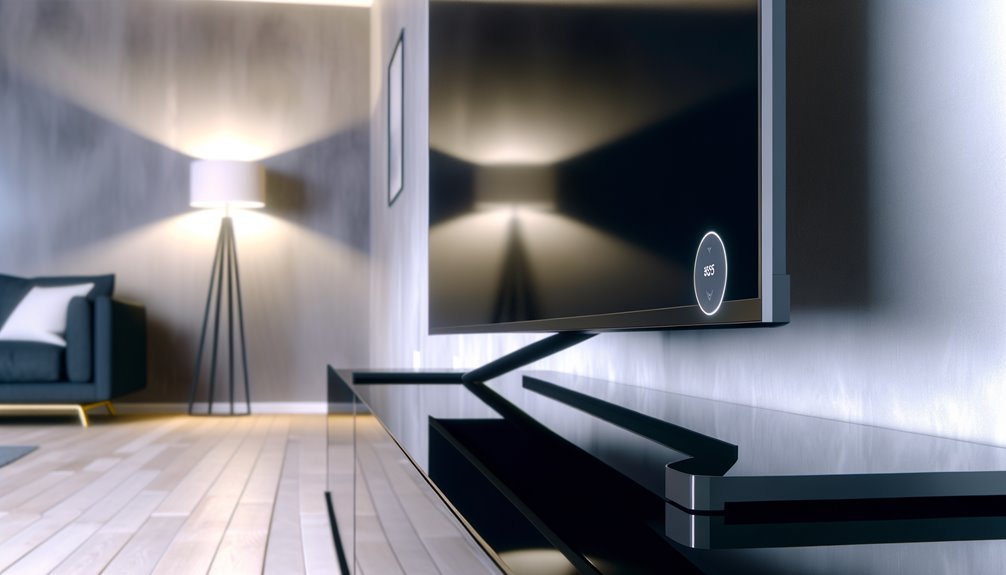When comparing 1080i and 1080p, the choice hinges on scanning technology and image quality. 1080i uses interlaced scanning, alternating rows of pixels to simulate a higher frame rate, which can cause motion artifacts in fast scenes. It's common in TV broadcasts and conserves bandwidth. On the other hand, 1080p employs progressive scanning, displaying each frame fully for sharper, clearer images, making it ideal for gaming and movies with fast motion. Modern devices typically support 1080p for superior visual fidelity. Still curious about the best format for your needs? There's more to uncover.
Key Information
- 1080i uses interlaced scanning while 1080p uses progressive scanning, resulting in higher clarity for 1080p.
- 1080p provides better performance in fast-motion scenes, reducing motion blur compared to 1080i.
- 1080i conserves bandwidth, making it suitable for TV broadcasting, whereas 1080p requires higher bandwidth.
- Modern gaming consoles and Blu-ray discs commonly use 1080p for enhanced visual fidelity and smoother graphics.
- 1080i requires deinterlacing on modern 1080p displays, whereas 1080p is natively compatible with these displays.
Understanding 1080i
When you're trying to understand 1080i, it's important to recognize that it employs interlaced scan technology, updating odd and even rows of pixels in an alternating fashion to conserve bandwidth and enhance motion perception. This method effectively doubles the perceived frame rate to 60 frames per second without requiring additional bandwidth.
Initially developed to overcome limitations in older display technology, 1080i remains prevalent in TV broadcasting. However, modern 1080p screens necessitate deinterlacing to display 1080i content at its best.
Be aware, though, that 1080i can exhibit motion artifacts during fast-moving scenes. Despite this, it continues to be widely used alongside 1080p content in various television programs, demonstrating its enduring relevance in the broadcasting industry.
Understanding 1080p
1080p, known as Full HD, offers a 1920×1080 pixel resolution with a progressive scan format, displaying each frame in its entirety for excellent image clarity and sharpness.
This format guarantees smoother visuals compared to interlaced formats, making it ideal for fast-motion scenes. You'll find 1080p commonly used in Blu-ray discs, which prioritize superior video quality.
Modern TVs and devices widely support 1080p, enabling you to enjoy high-definition content seamlessly.
Here's why 1080p stands out:
- Full frame display: Each frame is shown completely, reducing motion blur.
- Enhanced clarity: Higher pixel density offers better detail and sharpness.
- Wide compatibility: Supported by most contemporary TVs, Blu-ray players, and streaming devices.
Key Differences
To grasp the key differences between 1080i and 1080p, you need to understand that 1080i uses interlaced scanning while 1080p employs progressive scanning, leading to distinct variations in image quality and performance.
| Aspect | 1080i | 1080p |
|---|---|---|
| Scanning Method | Interlaced (odd/even rows alternately) | Progressive (entire image updated at once) |
| Image Quality | Lower clarity, potential flicker | Higher clarity, smoother visuals |
| Bandwidth Usage | More efficient for TV broadcasting | Higher bandwidth required |
| Motion Handling | Enhanced motion perception | Superior for fast motion scenes |
| Compatibility | Requires deinterlacing for 1080p displays | Native compatibility with modern displays |
Interlaced scanning in 1080i conserves bandwidth but may degrade image quality when displayed on 1080p screens due to necessary deinterlacing.
Performance in Gaming
Understanding the key differences between 1080i and 1080p is essential, especially when considering performance in gaming, where 1080p's progressive scanning guarantees smoother graphics and enhances the overall gameplay experience.
Gamers prefer 1080p for several reasons:
- Superior Image Quality: 1080p offers sharper details and crisper visuals, vital for immersive gaming.
- Reduced Motion Blur: Fast-moving scenes benefit from progressive scan, minimizing motion blur and providing clearer action sequences.
- Optimal Console Output: Modern gaming consoles and PCs are designed to output in 1080p, ensuring compatibility and peak performance.
Choosing 1080p over 1080i ensures your gaming setup can handle high-resolution content, maximizing visual fidelity and enhancing your gameplay. Always consider your display's capabilities to fully leverage 1080p's advantages.
Performance in Movies
In the domain of movie performance, 1080p delivers unparalleled visual clarity, rendering each frame with meticulous detail and fluid motion. The progressive scan of 1080p greatly reduces motion blur, enhancing your cinematic experience. Movie enthusiasts prefer 1080p for its ability to produce clearer and more immersive visuals, especially in high-action scenes. In contrast, 1080i struggles with interlacing artifacts, which can diminish image quality during fast-paced sequences.
Here's a quick comparison:
| Feature | 1080p | 1080i |
|---|---|---|
| Scan Type | Progressive Scan | Interlaced Scan |
| Motion Blur | Minimal | Higher |
| Image Clarity | Superior | Compromised |
| High-Action Scenes | Ideal | Suboptimal |
| Blu-ray Compatibility | Standard | Less Common |
Blu-ray discs often utilize 1080p to deliver the highest quality video for movie viewing, ensuring you get the best possible experience.
Choosing the Right Format
When choosing between 1080i and 1080p, you should consider factors like content type, viewing habits, and display capabilities to guarantee the best visual experience.
Here's a breakdown to help you decide:
- Content Type: For gaming and action-packed sports, 1080p offers smoother, clearer visuals. Traditional broadcasts may still favor 1080i.
- Display Size: Larger TVs over 42 inches more prominently reveal the differences between 1080i and 1080p, so opt for 1080p for larger screens.
- Source of Content: Blu-ray typically provides 1080p quality, whereas cable/satellite TV might broadcast in 1080i.
Ultimately, your personal viewing preferences will guide your choice. Evaluate these factors to make sure the format you select aligns with your needs and delivers an excellent viewing experience.
Frequently Asked Questions
What Is Better Quality, 1080P or 1080i?
You'd get better quality with 1080p due to its progressive scan technology. It delivers smoother graphics and sharper details, especially in fast-motion scenes, compared to 1080i's susceptibility to motion blur and jagged edges.
Is 1080P or 1080I Better for Gaming?
For gaming, you should choose 1080p over 1080i. 1080p's progressive scan delivers smoother, more detailed images, reduces motion blur, and minimizes jagged edges, enhancing your overall gaming experience with sharper and more realistic graphics.
Should I Set My Sky Q Box to 1080I or 1080p?
You should set your Sky Q Box to 1080p for the best image quality and smoother motion. Confirm that your TV supports 1080p to enhance your viewing experience. If unnoticed, 1080i might suffice for your needs.
Is 4K Better Than 1080i?
Yes, 4K is better than 1080i. 4K offers quadruple the pixel count, resulting in sharper, more detailed images. Despite limited content delivery due to compression challenges, 4K's superior clarity and realism make it the preferred choice.
Conclusion
When deciding between 1080i and 1080p, consider your specific needs.
For gaming, 1080p's progressive scan offers smoother visuals and reduced input lag, enhancing your experience.
In contrast, 1080i's interlaced format might suffice for standard broadcast TV, though it can introduce motion artifacts.
Ultimately, 1080p generally provides superior clarity and performance for both movies and gaming, making it the preferable choice for most modern applications.
Choose the format that aligns with your viewing and usage priorities.



